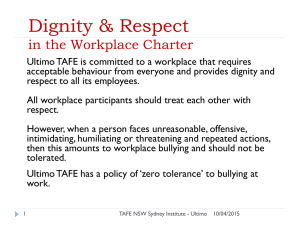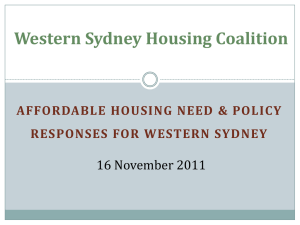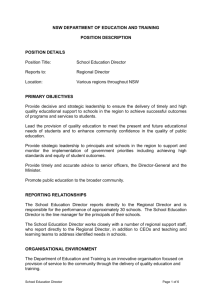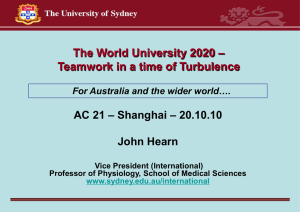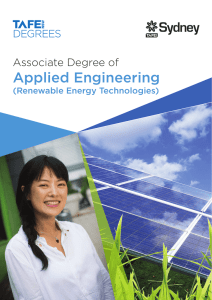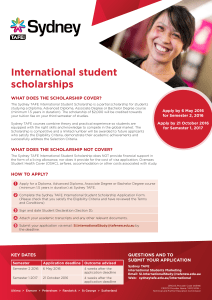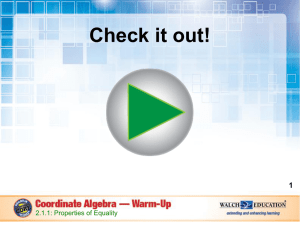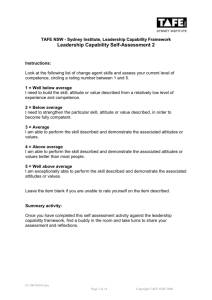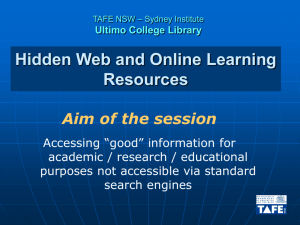Avery_presentation_slides_SIwebsite
advertisement
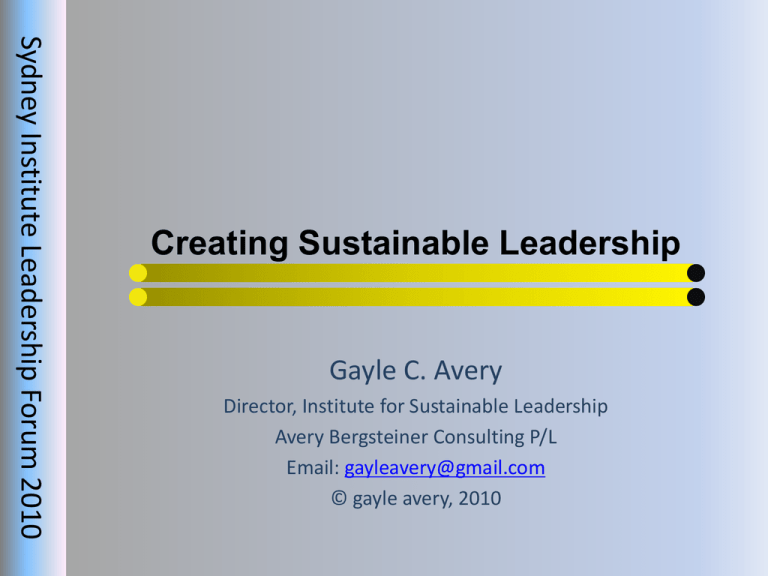
Sydney Institute Leadership Forum 2010 Creating Sustainable Leadership Gayle C. Avery Director, Institute for Sustainable Leadership Avery Bergsteiner Consulting P/L Email: gayleavery@gmail.com © gayle avery, 2010 AGENDA Introduction & background Strategy 2009-2012 Sustainable Leadership Pyramid – 23 elements Sustainable Leadership @ NSW TAFE Sustainable Leadership @ Sydney Institute Sydney Institute Strategic Plan 2009-2012 5 strategic priorities Priority 1: create a customer focused organisation, increase customer satisfaction. Priority 2: be innovative. Priority 3: engage your staff, raise performance. Priority 4: be systemic – get systems and processes in place. Priority 5: create a thriving & sustainable organisation. SUSTAINABLE LEADERSHIP CRITERIA 23 criteria form a self-reinforcing system whereby theory & research, and practice align theory & research (gurus & academics) practice (companies) Sustainable leadership Macro-level strategies for ensuring a thriving and sustainable enterprise for future generations More than being green & social financial success surviving & longevity Adding value to a range of stakeholders Early reference (2005): 19 criteria, now 23 LEADERSHIP FOR SUSTAINABLE FUTURES ACHIEVING SUCCESS IN A COMPETITIVE WORLD GAYLE C. AVERY 6 GRID ELEMENTS Honeybees (sustainable) Locusts (business-as-usual) 1. Developing people 2. Labor relations 3. Retaining staff 4. Succession planning 5. Valuing staff 6. CEO and top team 7. Ethical behaviour 8. Long term perspective 9. Organisational change 10. Financial markets 11. Environmental resp. 12. Social responsibility 13. Stakeholders 14. Vision’s role 15. Decision making 16. Self-management 17. Team orientation 18. Organisat’l culture 19. Knowledge sharing 20. Trust 21. Innovation 22. Staff engagement 23. Quality develop everyone continuously seeks cooperation values long tenure at all levels promotes from within where possible concerned about employees’ welfare CEO is top team member or speaker doing the right thing an explicit value long-term overrides short-term evolving and considered process seeks maximum independence protects the environment values people and the community everyone matters shared vision is strategic tool consensual and devolved staff are mostly self-managing teams are extensive and empowered an enabling, widely-shared culture spread throughout the organisation relationships and good-will based strong, systemic, strategic, at all levels emotionally committed is embedded in the culture develops people selectively acts antagonistically accepts high staff turnover appoints from outside where possible people are an interchangeable cost CEO is decision maker, hero ambivalent, negotiable, assessable risk short-term profits and growth prevail fast adjustment, volatile, ad hoc follows the markets, often slavishly is prepared to exploit the environment exploits people and the community only the shareholders matter here-and-now focused primarily manager-centered managers manage teams are limited & manager-centered weak, except for short-term focus limited to a few “gatekeepers” Control and monitoring in lieu of trust limited, selective, buys in expertise financial rewards govern motivation 7 is a matter of control World class company: Kärcher, based in Germany fits all sustainable leadership criteria keeps on hitting records eg in 2008: 1.4 billion euros turnover sold 6.38 million units about 7000 employees see graphs at: http://www.karcher.com/int/about_kaercher/F acts_and_Figures.htm. CREATING SUSTAINABLE LEADERSHIP how can I make sense of this list? which are the most important practices? which practices do I implement first? Answer: Use the Sustainable Leadership Pyramid The sustainable leadership pyramid SUSTAINABILITY brand & reputation customer satisfaction financial performance long-term shareholder value long-term stakeholder return PERFORMANCE OUTCOMES 23. innovation 22. staff engagement 21. quality KEY PERFORMANCE DRIVERS 20. devolved/ consensual decisionmaking 19. selfmanagement 18. team orientation 17. enabling culture 16. knowledge retention and sharing 15. trust HIGHER-LEVEL PRACTICES 1. strong, shared vision 2. stakeholder approach 3. social responsibility 4. environ’l responsibility 5. independence from financial markets 6. considered organisational change 7. long-term perspective 8. ethical behaviour 9. top-team leadership 10. valuing people 11. internal succession planning 12. long-term retention of staff 13. amicable labour relations 14. developing people continuously FOUNDATION PRACTICES © Harry Bergsteiner 2007 Where did Toyota go wrong? Use the pyramid to identify: What might have gone wrong at Toyota? Where would you start to fix it? GROUP ACTIVITY: TAFE NSW Table 1 analyses TAFE NSW’s strategic intentions in terms of 19 sustainable leadership criteria. Use a copy of the Sustainable Leadership Pyramid. As you experience TAFE’s influence, does the assessment in Table 1 ring pretty true on all variables? If not which ones need attention? Identify any gap(s) between aspiration and “reality”. Consider: what can/should the organisation do about those gaps? 30 minutes working time. Prepare answers for plenary discussion. WHAT ABOUT SYDNEY INSTITUTE? 1. How does your organisation fare on the 23 elements of sustainable leadership? 2. Which KPIs would you use to assess Sydney Institute’s performance on these elements? 3. How might you act differently under this model? EXAMPLES OF KPIs examples of key performance indicators (KPIs) for the sustainable leadership elements. 22. Staff engagement Engagement is the ‘motivational component’ of visionary leadership 3 behavioural components to engagement: SAY: speak positively about the business STAY: intend to stay with the business STRIVE: engaged staff work harder ‘Voice’ survey measures assess KPIs 8. Ethical behaviour integrity – what does this mean at Sydney Institute? code of conduct? is being ethical part of the performance management system or employee contract? treatment of Intellectual Property? 7. Long term perspective long term planning – how long? long term investments? long term Director and top team retention long term approach to innovation long term approach to finances…. 4. Environmental responsibility ISO 14001 etc accreditation incorporating into curricula build into all processes, facilities etc. minimise waste recycling systems measuring reductions in energy use and waste producing environmental reports 2. Stakeholder approach define relevant stakeholders how are relationships with each group measured? how is progress on these relationships reported and improved? 1. Vision (& values) is there a stated vision? is the vision shared and embedded in the culture? how many employees know the vision? how many use it to guide their behaviour? SUSTAINABLE LEADERSHIP @ SYDNEY INSTITUTE Your workbook contains: a copy of the pyramid a fresh page for each of the 23 elements Tables will be assigned 1-2 elements to discuss and report back on re: current situation desired situation actions required Time: 15 minutes. Plenary discussion: 35 minutes. Where have we been? Strategic priorities for 2012 Think systemically Sustainable Leadership Pyramid Sustainable leadership at NSW TAFE Sustainable leadership at Sydney Institute Forthcoming book: Avery, GC & Bergsteiner, H. (2010) Honeybees and Locusts: The Business Case for Sustainable Leadership. Allen & Unwin.
